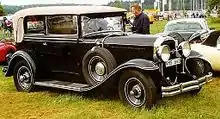Buick Standard Six
The Buick Standard Six was manufactured by Buick of Flint, Michigan, and was the junior model to the Buick Master Six between 1925 through 1929, and shared the GM A platform with Oldsmobile, Oakland and Chevrolet.[1] When the Buick 4-cylinder engine was cancelled it was the most popular Buick sold while being more upscale to the Oldsmobile Six. It was replaced by the Buick Series 40 in 1930, and was the senior brand to Marquette under the General Motors Companion Make Program until it was cancelled one year after introduction. It replaced the earlier Buick Six that was introduced in 1916, and was replaced with the Buick Special.
Buick Standard Six specifications (1926 data)
.jpg.webp)
.jpg.webp)
- Color – Brewster green
- Seating Capacity – Five
- Wheelbase – 114⅜ inches
- Wheels - Wood
- Tires - 31” × 4.95” balloon
- Service Brakes - contracting on four wheels
- Emergency Brakes - expanding on rear wheels
- Engine - Six cylinder, vertical, cast en block, 3 × 4½ inches; head removable; valves in head; H.P. 21.6 N.A.C.C. rating
- Lubrication – Force feed
- Crankshaft - Four bearing
- Radiator – Cellular
- Cooling – Water pump
- Ignition – High tension generator and storage battery
- Starting System – Single Unit
- Voltage – Six to eight
- Wiring System – Single
- Gasoline System – Vacuum
- Clutch – Dry plate, multiple disc
- Transmission – Selective sliding
- Gear Changes – 3 forward, 1 reverse
- Drive – Spiral bevel
- Rear Springs – Cantilever
- Rear Axle – Three-quarters floating
- Steering Gear – Worm and nut
Standard equipment
New car price included the following items:
- tools
- jack
- speedometer
- ammeter
- electric horn
- transmission theft lock
- automatic windshield cleaner
- spare tire carrier with extra demountable rim
- rear view mirror
- gasoline tank gauge
- parking lights on cowl
- headlight dimmers
- tail lamp
- instrument board lamp
- pressure grease gun
- windshield type ventilator
- dome light
- foot rest
- rear window curtain and sunshade
Prices
New car prices were F.O.B. factory, plus Tax:
- Five Passenger Coach - $1295
- Five Passenger Double Service Sedan - $1475
- Two Passenger Roadster - $1150
- Two Passenger Enclosed Roadster - $1190
- Five Passenger Touring - $1175
- Five Passenger Enclosed Touring - $1250
- Two Passenger Double Service Coupé - $1375
- Five Passenger Sedan - $1665
- Four Passenger Coupé - $1565
Series 40 (1930–1935)

When the Series 40 was introduced, it had the 257.5 cu in (4,220 cc) overhead valve Buick Straight-6 engine that produced 80.5 bhp of power at 2,800 rpm, and 74,257 examples were made, being the highest number of Buicks for 1930. For the year 1934, the Series 40 was temporarily discontinued, with the Series 50 being the entry level product. The 1935 version was introduced with the 233.0 cu in (3,818 cc) Buick Straight-8 engine and 93 bhp. In 1936 the name changed to "Special". The Series 40 was one market level above GM's junior brand to Buick, called Marquette Series 30.
References
- Georgano, N. (2000). Beaulieu Encyclopedia of the Automobile. London: HMSO. ISBN 1-57958-293-1.
- Source: Slauson, H. W.; Howard Greene (1926). ""Leading American Motor Cars"". Everyman’s Guide to Motor Efficiency. New York: Leslie-Judge Company.
- Kimes Beverly, Henry Clark, Standard Catalog of American Cars 1805–1942, Iola, Krause Publications Inc, 1996, ISBN 978-0-87341-428-9
.svg.png.webp)